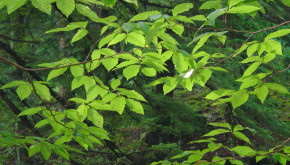
By Suzann Schiemer
Imagine taking a walk in the forest right now. You feel the earth and leaves under your feet, the snap of twigs. You listen to the birdsong and look up through the breaks in the canopy to the sky above, noticing how the light filters through to a point just further along the path. You breathe in, deeply. You smell the distinct forest aromas: moss, sap, earth and wood. You take it all in. - Y. Miyazaki
The above excerpt reads like a beautiful passage written by a naturalist expressing appreciation for the gifts bestowed by the forest. However, the passage represents much more, as Yoshifumi Miyazki is the deputy director of Chiba University’s Center for Environment, Health and Field Sciences in Japan. Miyazaki has spent years conducting research on the wellness practice of forest therapy. Through this research Miyazaki has documented the physiological effects on health and well-being from time spent in nature. The findings are welcome news for those of us who love spending time in Penn’s Woods.
Far from the forests of Japan, here in the United States we are learning about forest therapy and the research findings related to spending time in nature as a wellness practice. A variety of health and wellness related publications have featured articles addressing nature-based wellness under an assortment of titles such as forest therapy, Shinrin-yoku, forest bathing, nature therapy, ecotherapy and green exercise.
The body of knowledge related to nature-based wellness is robust. Often cited is data from the 14+ years of research conducted by Japanese researcher Dr. Qing Li. Dr. Li is the Chairman of the Japanese Society for Forest Medicine, a professor at the Nippon Medical School in Tokyo and one of the world’s leading experts on forest bathing. Dr. Li’s research data has shown the following benefits from practicing Shinrin-yoku: reduced blood pressure, lowered stress, improved cardiovascular and metabolic health, lower blood-sugar levels, improved concentration and memory, improved mood, improved pain thresholds, improved energy, boosted immune system, and weight loss.
According to Dr. Li, “When you connect to nature through all five of your senses, you begin to draw on the vast array of benefits the natural world provides.” When practicing Shinrin-yoku, you will walk at a gentle pace for two or more hours through the forest. Engagement of your senses supports your ability to take in the forest atmosphere. As you walk, notice the environment around you through your senses.
Notice what you are seeing; studies have found that shades of blues and greens lower arousal and anxiety. Notice the sounds of the forest; listen closely to the pleasant sounds of singing birds and murmuring water. Soothing sounds such as these have been cited for their ability to produce brain waves that help us relax. Notice the subtle and not so subtle aromas of the forest through your sense of smell. Take a few deep breaths inhaling the plant aromas; the scent of the white pines, the blossoming trees. Natural oils in forest plants are called phytoncides, and exciting research has provided evidence that our body’s immune system responds favorably to exposure to certain phytoncides in forested areas.
Notice what you touch and what is touching you. Feel the air current on your skin; come in direct contact with the trees. Studies have shown that physical contact with wood can induce physiological relaxation. Go ahead, hug that tree. Take a fresh, healthy snack with you to eat when you feel hungry and notice how it tastes. If you are interested in developing a personal practice of nature-based wellness, consider the following:
1. Select a natural area. Remember to look for a natural water element, a tree canopy with a mix of deciduous and evergreen trees, diverse ecosystems and a quiet area for a Sit Spot (see below).
2. The trail should be easy to walk; supporting a slow and gentle pace. You need not walk far or fast.
3. Select a Sit Spot Area. A sit spot area is a pleasant and comfortable spot in a natural area where you can sit and rest in quiet awareness.
4. Take a healthy and natural snack and water.
5. Give yourself permission to turn off the electronics during your time in nature.
6. Dress in layers for the weather conditions. It is difficult to relax and restore when you are too cold or hot.
This article has been edited for length. Suzanne Schiemer is a certified Forest Therapy Guide with the Association of Nature and Forest Therapy Guides and Programs. Formerly a teacher at the Bloomsburg Area School District for 36 years, Suzanne also works on educational initiatives for the PA Department of Education.
Read more from the Spring 2019 Women and Their Woods newsletter (Roots and Branches) online at www.delawarehighlands.org/watw.

